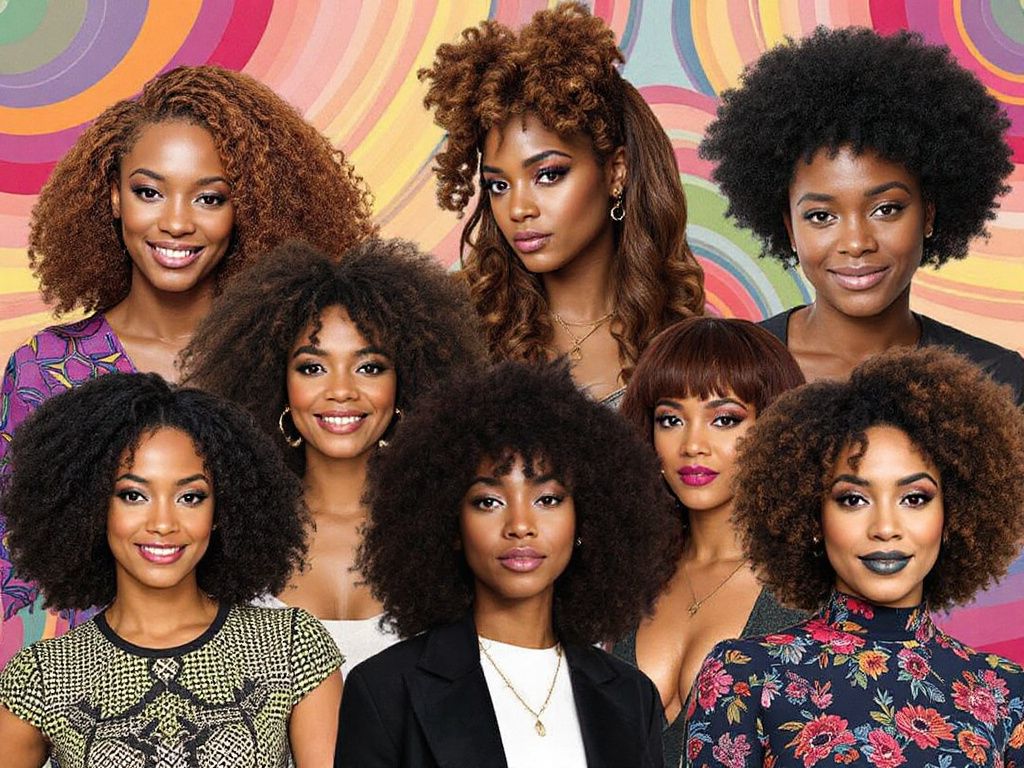
In the realm of personal hair care, individual narratives have a profound impact. Welcome to this Community Interview, where we delve into the inspiring stories of seven diverse individuals whose unique hair journeys have shaped insights, both personal and universal. These are not mere stories of style changes, but transformative experiences that underline the power of hair as a medium of identity, culture, and empowerment.
As someone deeply entrenched in the hair industry’s intricacies, I’ve witnessed firsthand the significant role hair plays in people’s lives. This journey curates community voices who have embraced their hair’s texture diversity and evolved through it. Here, we unite science, case studies, and practical insights, ensuring this piece becomes a trusted reference for those exploring the multifaceted world of hair transformations.
Transformation 1: Embracing the Curl 💁♀️
Our first story begins with Lisa, an executive from Chicago, who decided to embrace her natural curls after years of adherence to straightening methodologies. This transition didn’t only change her hair; it sparked a self-discovery journey that influenced her personal and professional life.
Technical Breakdown
**Chemical Relaxers versus Natural Curls:** Lisa’s transition involved a shift from chemical relaxers to nurturing her natural curl pattern. Chemical relaxants, using hydroxides or thioglycolates, break disulfide bonds in the hair, hence altering its structure permanently. According to a study published in the *Journal of Cosmetic Science*, prolonged use can weaken hair integrity significantly, calling the health of relaxed hair into question.
**The Journey of Curl Care:** Lisa adopted a curly girl method, which involves avoiding sulfates, silicones, and heat styling in favor of moisturizing products that enhance her natural curl pattern. This method is not only about defining curls but restoring hair’s inherent moisture balance, as highlighted in research by the *International Journal of Trichology*.
Real-World Application
Today, Lisa champions curly hair acceptance in corporate culture, influencing company guidelines to promote inclusivity in hair presentations. Her experience serves as a beacon for others reluctant to showcase their natural hair texture in professional environments.
Transformation 2: The Big Chop ✂️
For Jordan, a high school teacher in Los Angeles, the “big chop” was a bold declaration of embracing authenticity. After years of struggling to conceal his natural coiled hair under wigs, the chop was a leap into a new identity chapter.

Technical Walkthrough
**Transition Strategies:** The big chop, often characterized by cutting off chemically treated or damaged hair, spurs instantaneous transformation. Transition phases, like cutting hair above 70% processed portions, have seen positive psychological effects, reducing stress associated with maintenance, as demonstrated in a study by *Health Psychology Review*.
**Hair Typing Relevance:** Understanding hair typing, such as the Andre Walker Hair Typing System, helped Jordan determine effective care techniques. Proper typing (e.g., type 4 coily hair) guides individuals in selecting hyper-targeted products that cater to distinct texture needs.
Professional Insights
Jordan’s newfound enthusiasm translated into his classroom, fostering an atmosphere that encourages self-expression among students. His story is recognized within educational workshops as a vital boost to self-esteem and cultural identity.
Transformation 3: From Heat-Damaged to Heat-Free 🥵➡️❌🔥
Lian, a digital content creator based in Toronto, faced a dilemma many can relate to: severe heat damage. Her hair transformation tale centers around letting go of reliance on heat tools to nurture a healthy, texture-rich mane.
Expert Analysis
**Impact of Heat Damage:** Excessive heat styling can lead to loss of natural moisture and protein denaturation within hair strands, as documented by the *Journal of Cosmetic Dermatology*. Over time, this results in brittleness and split ends.
**Approaching Recovery:** Lian pivoted towards protective styling and incorporated deep-conditioning treatments rich in protein and moisture elements. Research indicates regular deep-conditioning can improve hair structure significantly, often reversing up to 30% of initial heat damage effects if begun early.
Case Study Applications
This change catalyzed Lian’s development of a digital content series that educates others on non-thermal styling alternatives, leveraging the momentum to advocate for natural hair positivity.
Transformation 4: Color Impact and Identity 🎨✨
Natalia, an artist living in Berlin, linked her hair to self-identity through color experimentation. Her narrative illustrates how color transitions, notably vivid dyes, can transform more than just aesthetics — they can reflect a dynamic personal ethos.
Cited Industry Data

**Color Chemistry:** The modification of hair color involves altering its natural pigment (melanin) through active agents like ammonia and peroxides. Studies from the *British Journal of Dermatology* indicate that while color treatments pose minimal structural risks if managed carefully, improper aftercare can compound dryness.
**Creativity Freeform:** Natalia explored temporary colors using semi-permanent and vegan dyes, minimizing the damage traditionally associated with vivid color applications. An album of her transformations became symbolic of her artistic phases, reshaping how her audience interacts with color.
Insights & Best Practices
Natalia’s practice shows that less drastic techniques, like ombre or balayage, can infuse vibrant colors without overwhelming natural texture, balancing vibrance with hair health.
Transformation 5: Cultural Reclamation through Texture 🌐🤲
Elijah, originally from Ghana, experienced hair as a confluence of cultural heritage and contemporary life. Reclaiming traditional hair practices altered his life unexpectedly during his time at university in New York.
Standards and Best Practices
**Ethnobotanical Practices:** Inspired by his roots, Elijah turned to ethnobotanical methods involving native ingredients, such as shea butter and coconut oil. These natural substances are renowned not just for moisturization but also for their protective qualities, validated by the *Journal of Ethnopharmacology*.
**Community Impact:** Cultural hair traditions are wealth vessels and modes of cultural expression, as seen through Elijah’s foundation of a community group promoting ancestral hair care knowledge among diaspora youth.
Diagrams & Structured Insights
The initiative drew its framework from cultural competency standards, echoing protocols that advocate for sustainable ingredient sourcing and respect for traditional knowledge systems.
Transformation 6: Breaking Societal Norms 🌟🚫
Faced with strict professional codes, Avery, a former banking professional, defied expectations by maintaining her voluminous Afro after stepping into the management role. Her battle against workplace hair discrimination conveys a gradual societal shift towards texture acceptance.

Technical Breakdown
**Policy Development:** Avery engaged with initiatives that scrutinize workplace policies, ensuring they nurture inclusivity. Her influence has been bolstered by movements like the CROWN Act, working to dismantle hair discrimination.
**Evidence-Based Approaches:** Data emphasizes that recognizing and accommodating natural hair in professional spaces contributes positively to diversity and inclusion metrics. Studies supporting this emphasize improved turnover and morale across diverse employee bases.
Professional Insights
Avery redefined the prototypical leadership persona in finance, showcasing that leadership remains unbounded by rigid appearance constraints.
Transformation 7: From Scarcity to Abundance 🥰🌱
Lastly, we meet Maya, a healthcare worker in Mumbai, whose path led her from thinning hair distress to discovering abundant tresses through innovative care.
Research-Based Insights
**Understanding Hair Loss:** Maya confronted conditions like alopecia, often exacerbated by stress and lifestyle. A comprehensive regimen combining diet alterations and scalp PRP (Platelet-Rich Plasma) therapy marked a turn-around, characterized by increased density as reported in the *International Journal of Women’s Dermatology*.
**Diet and Wellness Synergy:** The intersection of nutrition — emphasizing proteins and omega fatty acids — supports optimal hair growth. This holistic approach, underpinned by such studies, propelled Maya to blog about the intersectionality of diet and hair health.
Structured Advice
Maya’s holistic therapy, with patience and persistence, dispels myths around irreversible hair loss, promoting strategies accessible to many.
—
Whether embracing natural texture, exploring bold colors, or defying conventions, these stories encapsulate the myriad ways hair transformations transcend individual paradigm shifts into wider collective phenomena. Let these stories guide and inspire you on your distinctive hair journey, embracing every texture and every tale along the way.
Hair is more than a strand of keratin — it’s a thread to our identities, binding our heritage, journeys, and communities into a singular, beautiful tapestry.
Frequently Asked Questions
What are the benefits of using a hair mask in my hair care routine?
Using a hair mask can provide several benefits, including hydration, smoothing, strengthening, curl definition, heat protection, and damage repair. Hair masks infuse the hair with moisture, help coat the hair shaft to seal split ends, reduce breakage, and protect the hair from heat styling and environmental damage[1][4].
What ingredients should I look for in a hair mask?
Effective hair masks often include ingredients such as coconut oil, argan oil, shea butter, honey, avocado oil, green tea, and coconut water. These ingredients provide nourishment, moisturize, and protect the hair, offering benefits like softening, moisturizing, and protecting against damage[2][5].
How often should I use a hair mask in my routine?
You should use a hair mask whenever your hair feels dry, unmanageable, or in need of intense hydration. This can vary depending on your hair type and needs, but generally, using a hair mask once or twice a week can help maintain healthy and moisturized hair[1][4].
How do I apply a hair mask for the best results?
To apply a hair mask effectively, shampoo your hair first, then apply the mask, focusing especially on the ends where hair tends to be the most damaged. Leave the mask on for anywhere from 10 minutes to overnight, depending on the type of mask and your hair’s needs[1][4].
References


Leave a Reply